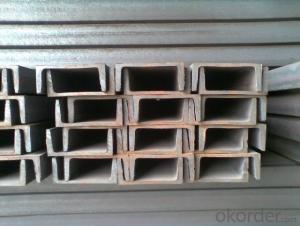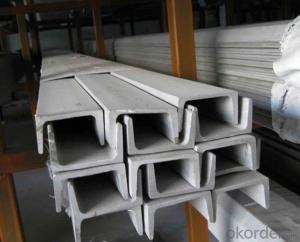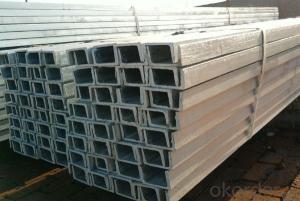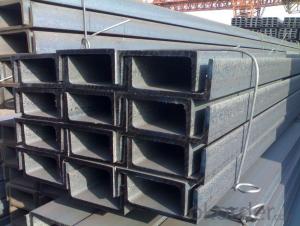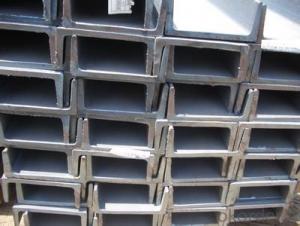Hot Rolled U CHANEEL 5-300mm or High Quality GB OR JIS
- Loading Port:
- China Main Port
- Payment Terms:
- TT or LC
- Min Order Qty:
- -
- Supply Capability:
- -
OKorder Service Pledge
OKorder Financial Service
You Might Also Like
Product Description:
OKorder is offering high quality Hot Rolled Steel I-Beams at great prices with worldwide shipping. Our supplier is a world-class manufacturer of steel, with our products utilized the world over. OKorder annually supplies products to European, North American and Asian markets. We provide quotations within 24 hours of receiving an inquiry and guarantee competitive prices.
Product Applications:
1.The JIS U Channel Steel can be devided into two kinds, namely common channel steel and light channel steel. The sizes of hot rolled common channel steel range from 5# to 40#. Meanwhile, the channel steel can be divided into cold forming sectional equal channel steel, cold forming sectional unequal channel steel, cold forming inner edge channel steel and outer edge channel steel.
2.The JIS u channel steel is usually used for arch-itechtural structure, and they could be welded in order to support or hang a vari-ety of facilities. They are also usually used in combination with I beam. The channel steel with sizes under 14# is usually applied to construction engineering, as purline, while the channel steel with sizes above 16# is more likely to be used in building vehicle chassis structure and mechanical structure. Furthermore, the channel steel in sizes above 30# are target at building bridge structure, as tension bar.
3.In a word, the channel steel must possess perfect welding property, riveting property and mechanical property and so on.
Product Advantages:
OKorder's Steel I-Beams are durable, strong, and resist corrosion.
Main Product Features:
· Premium quality
· Prompt delivery & seaworthy packing (30 days after receiving deposit)
· Corrosion resistance
· Can be recycled and reused
· Mill test certification
· Professional Service
· Competitive pricing
Product Specifications:
Manufacture: Hot rolled
Grade: Q195 – 235
Certificates: ISO, SGS, BV, CIQ
Length: 6m – 12m, as per customer request
Packaging: Export packing, nude packing, bundled
Original Place | Tangshan, China | Brand Name | UINDA |
Standard | JIS G3192 : 1990 | ||
Material Grade | SS490 | ||
Sizes | 50mm to 200mm | ||
Sales Volume/Year | 3000MT | ||
Destination Area | Middle East, Africa, Southeast Asia | ||
2. The sections in details are as followings in the table-1
JIS U CHANNEL | Standard | Sectional | Dimension |
| Mass: |
| (mm) | (mm) | (mm) | (mm) |
|
50x25 | 50 | 25 | 3.0 | 6.00 | 2.37 |
75X40 | 75 | 40 | 3.8 | 7.00 | 5.30 |
75X40 | 75 | 40 | 4.0 | 7.00 | 5.60 |
75X40 | 75 | 40 | 4.5 | 7.00 | 5.85 |
75X40 | 75 | 40 | 5.0 | 7.00 | 6.92 |
|
|
|
|
|
|
100X50 | 100 | 50 | 3.8 | 6.00 | 7.30 |
100X50 | 100 | 50 | 4.2 | 6.00 | 8.03 |
100X50 | 100 | 50 | 4.5 | 7.50 | 8.97 |
100X50 | 100 | 50 | 5.0 | 7.50 | 9.36 |
|
|
|
|
|
|
125X65 | 125 | 65 | 5.2 | 6.80 | 11.66 |
125X65 | 125 | 65 | 5.3 | 6.80 | 12.17 |
125X65 | 125 | 65 | 5.5 | 8.00 | 12.91 |
125X65 | 125 | 65 | 6.0 | 8.00 | 13.40 |
|
|
|
|
|
|
150x75 | 150 | 75 | 5.5 | 7.30 | 14.66 |
150x75 | 150 | 75 | 5.7 | 10.00 | 16.71 |
150x75 | 150 | 75 | 6.0 | 10.00 | 17.90 |
150x75 | 150 | 75 | 6.5 | 10.00 | 18.60 |
150x75 | 150 | 75 | 6.5 | 10.00 | 24.00 |
|
|
|
|
|
|
200X80 | 200 | 80 | 7.5 | 11.00 | 24.60 |
3. The mechanical property of JIS U Channel Steel in the table-2:
Grade | Yield Strength,N/mm² | Extension Strength N/mm² | |||
Thickness of Steel,mm | |||||
≦16 | >16-≦40 | >40-≦100 | >100 | ||
SS490 | ≧285 | ≧275 | ≧255 | ≧245 | 490-610 |
4. The chemical composition of JIS U Channel Steel as per SS490 in the table-3
Grade | Element(%) | |||
C | Mn | P | S | |
SS490 | - | - | ≦0.050 | ≦0.050 |
FAQ:
Q1 Can stainless steel rust?
A1 Stainless does not "rust" as you think of regular steel rusting with a red oxide on the surface that flakes off. If you see red rust it is probably due to some iron particles that have contaminated the surface of the stainless steel and it is these iron particles that are rusting. Look at the source of the rusting and see if you can remove it from the surface.
Q2: How do you package the angle steel when shipping?
A2: All goods are packed in bundles with steel strips and shipped by container or break bulk.
Q3: The products are invoicing on theoritical weight or on actual weight?
A3: We can do it in both manners, according to the customers' request.
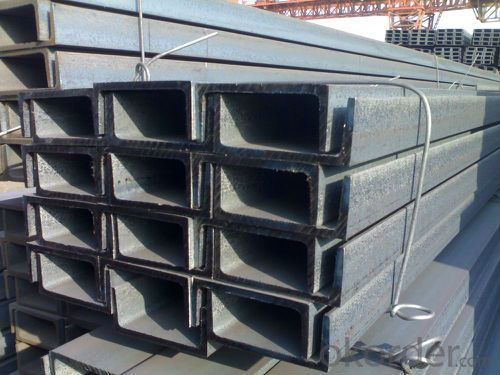
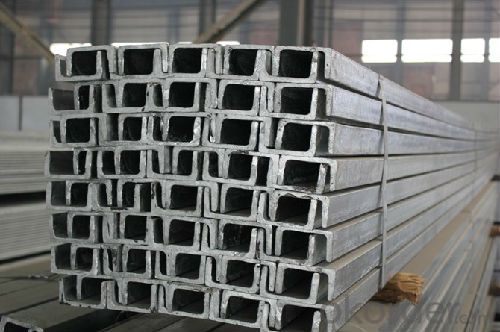
- Q: What are the different welding methods for steel channels?
- There are several different welding methods that can be used for steel channels, depending on the specific application and desired results. Some of the most common welding methods for steel channels include: 1. Shielded Metal Arc Welding (SMAW): Also known as stick welding, SMAW involves using an electrode coated in flux to create an arc between the electrode and the base metal. This method is versatile and can be used for both thick and thin steel channels, making it suitable for a wide range of applications. 2. Gas Metal Arc Welding (GMAW): Commonly referred to as MIG welding, GMAW uses a continuous wire electrode that is fed through a welding gun. The wire is melted and joined with the base metal while being shielded by a gas, typically a mixture of argon and carbon dioxide. This method is known for its speed and efficiency, making it ideal for high-volume production of steel channels. 3. Flux-Cored Arc Welding (FCAW): Similar to GMAW, FCAW utilizes a continuous wire electrode, but instead of using a shielding gas, it uses a flux-filled tubular wire. This flux creates a protective shield around the weld, eliminating the need for an external gas supply. FCAW is commonly used for outdoor applications or in environments with strong drafts that could blow away the shielding gas. 4. Gas Tungsten Arc Welding (GTAW): Also known as TIG welding, GTAW uses a non-consumable tungsten electrode to create an arc and heat the base metal. A separate filler rod is then manually fed into the weld pool, creating the joint. GTAW is known for its precision and control, making it suitable for welding thin steel channels or when a high-quality weld is required. 5. Submerged Arc Welding (SAW): SAW involves feeding a continuous wire electrode into the joint while a layer of granular flux covers the weld zone. The arc is submerged beneath the flux, providing a protective atmosphere and preventing the weld from being exposed to the surrounding air. This method is commonly used for thicker steel channels or when high deposition rates are required. It is important to consider the specific requirements of the steel channel and the intended application when selecting a welding method. Each method has its advantages and limitations, so it is crucial to choose the most appropriate method for achieving the desired results in terms of strength, aesthetics, and efficiency.
- Q: What are the common accessories used with steel channels?
- Some common accessories used with steel channels include brackets, fasteners (such as bolts, screws, and rivets), connectors, clips, and end caps. These accessories are used to secure and connect steel channels to other structural elements, provide additional support, and enhance the overall functionality and stability of the channel system.
- Q: How do steel channels perform in seismic zones?
- Steel channels perform well in seismic zones due to their inherent strength and flexibility. The channels are able to absorb and distribute seismic forces, reducing the risk of structural failure during earthquakes. Additionally, steel channels can be designed and reinforced to meet the specific requirements of seismic zones, making them a reliable choice for construction in such areas.
- Q: [20a what is the surface area of the channel steel? I think it should be used as a fireproof paint
- 20A channel steel international size is 200*73*7, 1 meters of channel steel surface area is 0.678 square meters, not counting ends
- Q: What are the considerations for steel channel connections to steel beams?
- When considering steel channel connections to steel beams, there are several important factors to take into account. First and foremost, it is crucial to ensure that the connection is structurally sound and capable of withstanding the intended loads and forces. This requires a thorough analysis of the design requirements and specifications, including the anticipated loads, the geometry of the channel and beam, and any applicable building codes or regulations. One consideration is the type of connection that will be used. Common options include welding, bolting, or a combination of both. The choice will depend on factors such as the strength requirements, the ease of installation, and any specific constraints or limitations imposed by the project. Another consideration is the connection detailing. This involves determining the specific dimensions, tolerances, and clearances required for the connection to ensure a proper fit and alignment. The detailing should also consider any potential issues that may arise during fabrication, transportation, and erection, such as distortion or misalignment of the components. Furthermore, it is important to consider the potential for corrosion and its impact on the connection. Steel channel connections to steel beams are susceptible to corrosion, especially in environments with high humidity, saltwater exposure, or chemical contaminants. Proper corrosion protection measures, such as coatings, galvanization, or the use of corrosion-resistant materials, should be implemented to ensure the longevity and durability of the connection. Additionally, the connection method should allow for any necessary adjustments or modifications. This is particularly important in cases where the channel may need to be repositioned or replaced in the future. The connection should be designed to allow for easy disconnection, reconnection, or adjustment without compromising the overall structural integrity. Lastly, it is crucial to consider the cost and time implications of the chosen connection method. Different connection methods have varying costs and installation times, and these factors should be weighed against the project budget and schedule. In conclusion, the considerations for steel channel connections to steel beams involve structural integrity, connection type, detailing, corrosion protection, adjustability, and cost/time implications. By carefully addressing these factors, a reliable and efficient connection can be achieved, ensuring the overall stability and strength of the steel structure.
- Q: How do steel channels perform in extreme temperatures?
- Steel channels are renowned for their exceptional performance in extreme temperatures, exhibiting a remarkable ability to withstand high heat without warping or deforming due to their high melting point. As a result, they find extensive use in industries demanding heat resistance, such as automotive, aerospace, and construction sectors. In addition, steel channels exhibit impressive performance even in frigid temperatures. This is attributed to the fact that steel possesses a low coefficient of thermal expansion, meaning it undergoes minimal contraction or expansion when subjected to temperature fluctuations. Consequently, steel channels retain their structural integrity and dimensional stability even in freezing conditions. Moreover, steel channels boast excellent thermal conductivity, enabling efficient heat transfer. This attribute proves particularly advantageous in extreme temperature environments, as it ensures the uniform distribution of heat, preventing the formation of localized hot spots or cold spots. Taken together, the reliability of steel channels in extreme temperatures renders them the preferred choice for various applications where temperature resistance is of utmost importance.
- Q: What are the maximum lengths available for steel channels?
- The maximum lengths available for steel channels can vary depending on the manufacturer and the specific type of channel being used. However, standard lengths typically range from 20 feet to 40 feet. Some manufacturers may offer longer lengths, such as 60 feet or more, depending on the requirements of the project and the capabilities of the manufacturer's equipment. It is important to consult with the manufacturer or supplier to determine the available lengths for the specific steel channel being considered for use.
- Q: Can steel channels be used for electrical wiring?
- No, steel channels cannot be used for electrical wiring. Steel channels are typically used for structural support in construction and are not designed to contain electrical wires. Electrical wiring requires specific types of conduits or cable trays that are made of materials like PVC or metal, which are specifically designed to safely contain and protect electrical wires. These conduits or cable trays provide insulation and prevent any potential electrical hazards, such as short circuits or electrical shocks. Therefore, it is important to use the appropriate materials and methods specifically designed for electrical wiring to ensure safety and compliance with electrical codes and regulations.
- Q: 24 meters long, 4 meters per column, 6 meters wide. How large channel steel should be used to make the beam?
- It is assumed that the channel material is Q235, model 14a, vertical, 3.5m, center force, and the maximum load is P.
- Q: Can steel channels be customized according to specific requirements?
- Yes, steel channels can be customized according to specific requirements. Manufacturers can tailor the dimensions, lengths, thicknesses, and finishes of steel channels to meet the specific needs and preferences of customers.
Send your message to us
Hot Rolled U CHANEEL 5-300mm or High Quality GB OR JIS
- Loading Port:
- China Main Port
- Payment Terms:
- TT or LC
- Min Order Qty:
- -
- Supply Capability:
- -
OKorder Service Pledge
OKorder Financial Service
Similar products
Hot products
Hot Searches
Related keywords
